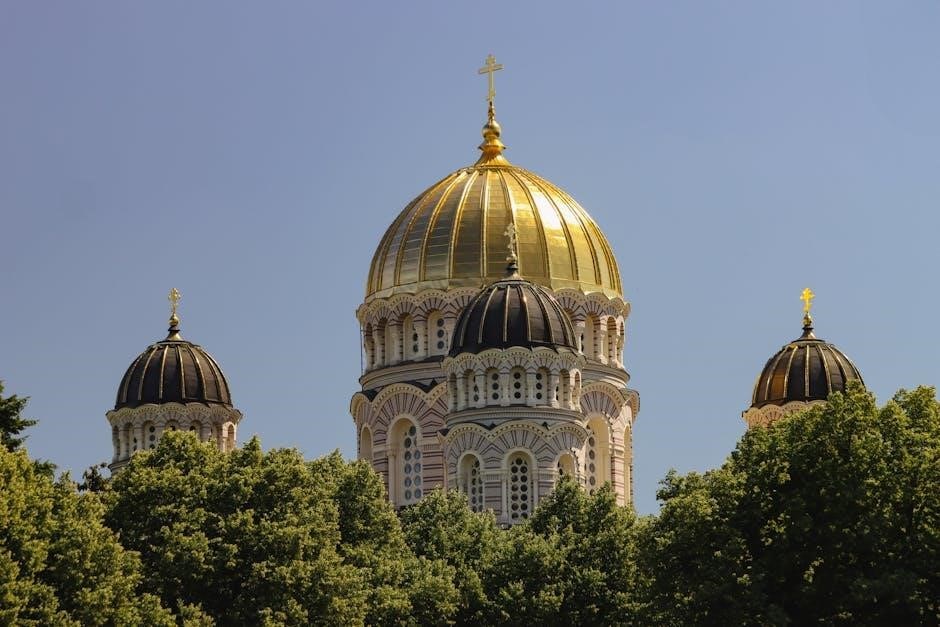Burning rituals are a core element in witchcraft, symbolizing transformation, empowerment, and spiritual connection. Fire’s purifying power helps release negativity, manifest change, and honor nature’s cycles through intentional practices.
1.1 The Significance of Fire in Witchcraft
Fire holds profound symbolic and practical importance in witchcraft, representing transformation, purification, and renewal. It embodies the element of change, empowering rituals for release, protection, and healing. Fire is often used to cleanse spaces, banish negativity, and amplify intentions. Whether through candle burning, bonfires, or smudging with herbs, fire’s transformative power aligns with the witch’s goal of manifesting change and honoring nature’s cycles; Its presence in rituals fosters a deep spiritual connection, symbolizing renewal and empowerment.
1.2 Brief History of Burning Rituals
Burning rituals trace their origins to ancient pagan practices, where fire symbolized purification and transformation. Early cultures used sacred woods like oak and ash in ceremonial fires to honor deities and mark seasonal changes. These traditions evolved into modern witchcraft, incorporating elements like candle magic and herbal burning. Historical records show fire’s enduring role in spiritual practices, bridging ancient and contemporary rituals. This rich history underscores fire’s timeless significance in witchcraft, connecting practitioners to their ancestors and natural cycles.
1.3 Why Burning is a Powerful Magical Tool
Burning is a potent magical tool due to its dual nature of destruction and creation. Fire transforms matter, symbolizing release and renewal, allowing practitioners to let go of negativity and manifest change. It purifies spaces, objects, and energies, creating a clean slate for new intentions. The act of burning also amplifies focus and intention, making it a versatile element in spells, cleansings, and rituals. This makes fire a cornerstone in witchcraft, offering both practical and symbolic power for spiritual growth and transformation.
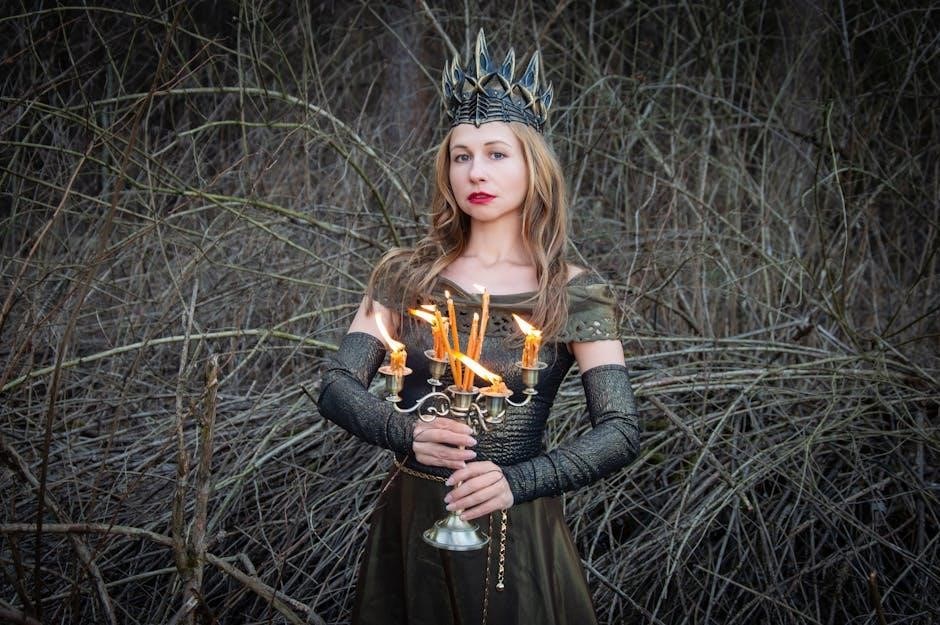
Spiritual Meaning of Burning
Burning symbolizes transformation, renewal, and purification, allowing the release of negativity and embracing new growth. Fire’s elemental power facilitates spiritual cleansing and fosters a deeper connection to magic.
2.1 Transformation and Renewal
Burning rituals embody transformation and renewal, mirroring fire’s natural ability to destroy the old and birth the new. This process symbolizes personal growth, as releasing past burdens allows for rebirth and renewal. Fire’s transformative power aids in shedding limiting beliefs and emotions, clearing space for fresh perspectives and opportunities. Through intentional burning, witches harness this elemental energy to catalyze change, fostering resilience and spiritual evolution. This practice deeply resonates with nature’s cycles of renewal.
2.2 Purification and Cleansing
Burning rituals are potent tools for purification and cleansing, utilizing fire’s innate ability to remove impurities. This practice eliminates negative energies, cleanses spaces, and restores balance. Whether through herbs, candles, or paper, burning symbolizes the eradication of unwanted influences. The act of purifying with fire creates a sacred space for renewal, offering a fresh start and aligning energy with positive intentions. This ancient technique remains a cornerstone in witchcraft, fostering clarity and harmony in both personal and environmental realms.
2.3 Letting Go and Release
Burning rituals offer a powerful method for letting go of emotional, mental, or spiritual burdens. By symbolically releasing attachments through fire, practitioners liberate themselves from past traumas, negative patterns, or stagnant energies. This act of surrender allows for renewal and healing, creating space for new growth and positive change. The transformative power of fire aids in releasing what no longer serves, fostering personal freedom and renewal. It’s a cathartic practice deeply rooted in witchcraft traditions, empowering individuals to embrace transformation and move forward.
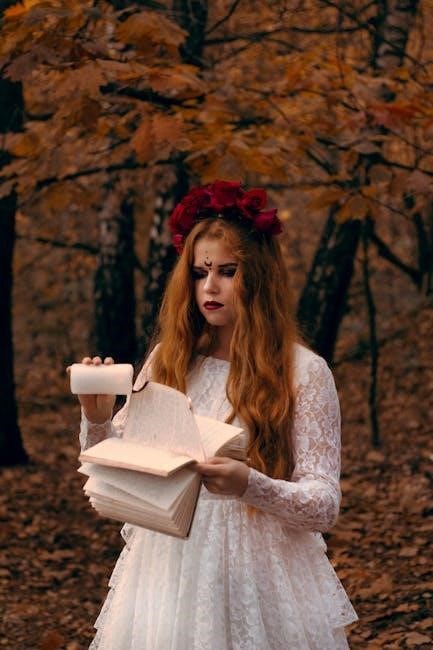
Types of Burning Rituals
Burning rituals include candle burning for intentions, herbal and resin burning for cleansing, and paper burning for release, each offering unique magical effects.
3.1 Candle Burning Rituals
Candle burning rituals are a popular and versatile practice in witchcraft, utilizing the flame’s transformative energy. By selecting specific candle colors aligned with intentions, practitioners can manifest desired outcomes, such as love, prosperity, or protection. The ritual often involves focused meditation, chants, or affirmations to channel energy. Once the candle burns out, the intention is released into the universe, symbolizing completion and trust in divine manifestation. This practice is both intimate and powerful, making it a staple in many witches’ spellwork.
3.2 Herbal and Resin Burning
Herbal and resin burning is a powerful practice in witchcraft, offering a way to cleanse, consecrate, and enchant spaces. Herbs like sage, lavender, and sweetgrass are burned for purification and protection, while resins such as frankincense and myrrh are used for their magical and medicinal properties. These substances are often combined with specific intentions, releasing their essence into the air to manifest change. The smoke carries prayers and energies, creating a sacred atmosphere for rituals, healing, and spiritual connection, making it a versatile tool for witches seeking transformation and balance.
3.3 Paper Burning for Release
Paper burning is a simple yet powerful ritual for release. By writing down what you wish to let go of—emotional burdens, negative patterns, or harmful habits—and burning the paper, you symbolically release these weights. The fire transforms and clears the energy, allowing space for renewal and positive growth. This practice offers emotional catharsis, helping you move forward with clarity and intention.

Candle Burning Rituals
Candle burning rituals harness fire’s transformative power for focus, intention, and manifestation. By selecting candles of specific colors and scents, practitioners channel energy to attract desired outcomes, fostering clarity and renewal.
4.1 Preparing for a Candle Burning Ritual
Preparing for a candle burning ritual involves setting clear intentions and creating a sacred space. Begin by cleansing the area with sage or incense to remove negative energy. Choose a candle color that aligns with your intent, such as green for abundance or blue for calm. Anoint the candle with oils to enhance its magical properties. Write your intention on paper, fold it, and place it under the candle. Gather tools like matches, a snuffer, and a fire-safe container. Center yourself through meditation or deep breathing to focus your energy. Ensure all distractions are minimized, and the environment feels peaceful and conducive to magic. This intentional preparation honors the ritual’s purpose and amplifies its effectiveness.
4.2 Choosing the Right Candle Color
Candle colors hold specific meanings in witchcraft, aligning with your ritual’s intent. Green symbolizes abundance and prosperity, while blue represents calmness and healing. Red embodies passion or strength, and purple is for spiritual growth or wisdom. White candles are versatile, often used for purification or clarity. Black candles are chosen for protection or banishing negative energy. Select a color that resonates with your goal to enhance the ritual’s effectiveness and focus your magical intentions.
4.3 How to Interpret the Flame
The flame’s behavior during a candle burning ritual offers insights into your magic’s effectiveness. A steady, bright flame often signifies alignment with your intention and positive energy flow. Flickering or dimming may indicate resistance or external influences. Smoke color can also carry meaning—white for clarity, gray for stagnation, and black for negative energy release. Observing these signs helps refine your practice, ensuring your rituals manifest their desired outcomes with greater precision and spiritual alignment.
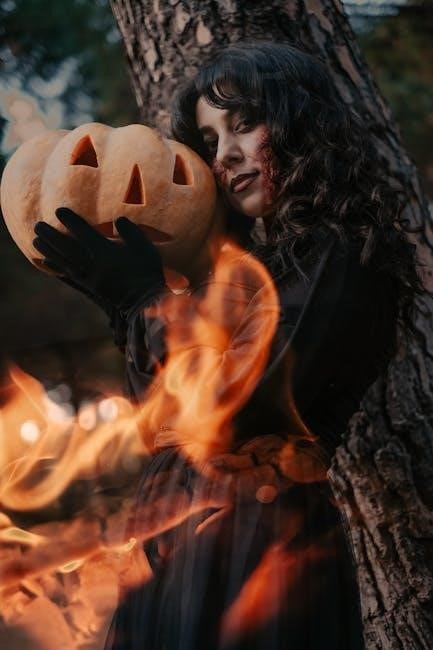
Herbal and Resin Burning
Burning herbs and resins like sage, lavender, and sandalwood is a potent way to purify, protect, and enhance magical workings, fostering spiritual growth and intentional energy alignment.
5.1 Herbs Commonly Used in Rituals
Herbs like sage, lavender, and chamomile are widely used in rituals for their cleansing and protective properties. Sage purifies spaces, while lavender promotes peace and harmony. Chamomile soothes emotions and attracts positive energy. Other popular herbs include rosemary for mental clarity, thyme for healing, and patchouli for grounding. These herbs are burned to release their essence, creating a sacred atmosphere for meditation, spellwork, and spiritual connection. Each herb carries unique magical properties, making them versatile tools in witchcraft practices.
5.2 Resins and Their Magical Properties
Resins like frankincense, myrrh, and dragon’s blood are prized for their potent magical and aromatic qualities. Frankincense enhances spiritual connection and offers protection, while myrrh promotes emotional healing and grounding. Dragon’s blood is used for banishing negativity and amplifying spells. These resins, when burned, release their essence, creating a powerful magical environment. Their ancient uses in rituals make them essential tools for witches seeking to deepen their practice and manifest desired outcomes through their transformative properties.
5.3 Blending Herbs for Specific Intentions
Blending herbs allows witches to create customized magical blends for specific intentions. Common combinations include sage for purification, lavender for calmness, and chamomile for healing. Frankincense and myrrh are often mixed for protection and spiritual growth. Dragon’s blood resin is added to amplify spells and banish negativity. When blending, focus on the intent and energy you wish to manifest. Experiment with ratios and scents to tailor your rituals, ensuring each herb complements the others for a powerful, balanced effect.
Burning Rituals for Letting Go
Burning rituals for letting go involve releasing negative emotions, habits, or patterns; Write down what you wish to release, then burn it, symbolizing transformation and cleansing through fire.
6.1 Writing Down What You Want to Release
Writing down what you want to release is a powerful step in burning rituals. It clarifies intentions and emotionally prepares you for transformation. Use a journal or paper to list fears, regrets, or habits. Be specific and honest, as this act symbolizes commitment to letting go. Once written, burning the paper during the ritual signifies release, allowing you to surrender burdens and embrace change.
6.2 Performing a Burning Bowl Ritual
A burning bowl ritual is a potent way to release negativity. Use a safe, heat-resistant container like a metal or glass bowl. Write down what you wish to release on paper, then burn it, visualizing the flames consuming your burdens. Perform this in a peaceful, focused space, aligning your intentions with the fire’s transformative energy. This act symbolizes liberation, allowing you to let go and embrace renewal.
6.3 Symbolism of Fire in Release Rituals
Fire embodies transformation and renewal, making it a powerful symbol in release rituals. It represents the destruction of old patterns, clearing space for new growth. The act of burning releases emotional or spiritual burdens, while the flames purify and cleanse. This practice mirrors nature’s cycles, where fire sparks regeneration. By harnessing fire’s energy, one can symbolically release negativity, embracing change and fostering personal liberation. The fire’s light guides the journey toward renewal and inner peace, reinforcing its sacred role in witchcraft.
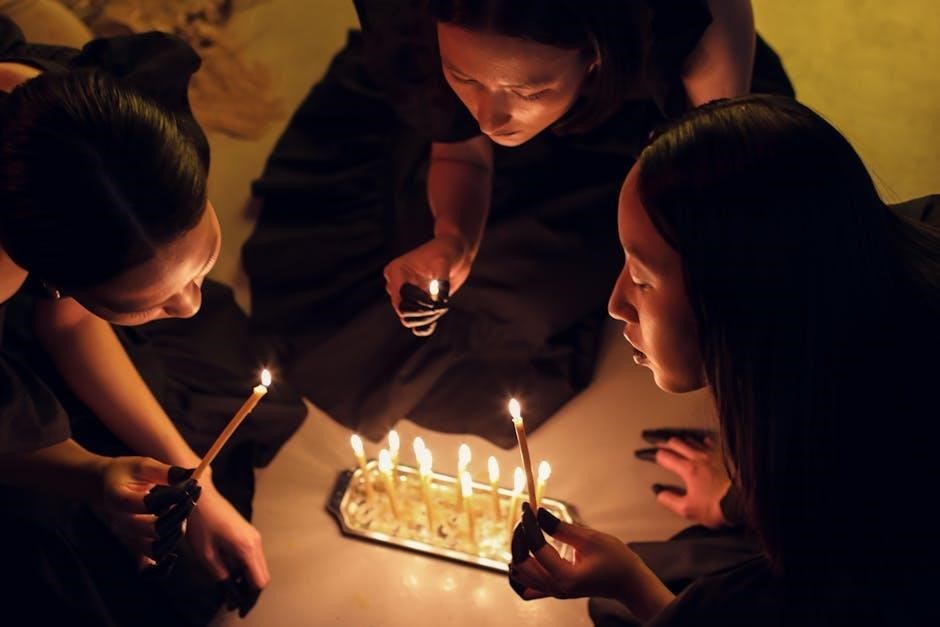
Safety in Burning Rituals
Ensure safe burning rituals by using fireproof containers, maintaining a clear space, and keeping water nearby. Prioritize ventilation and avoid flammable materials to prevent accidents.
7.1 Choosing a Safe Location
Always perform burning rituals in a safe, open space away from flammable materials. Ensure good ventilation to prevent smoke buildup and avoid confined areas. For outdoor rituals, check weather conditions to prevent uncontrolled spread. Use a heat-resistant container or fire pit, and keep water or a fire extinguisher nearby. Never burn near curtains, wood, or dry leaves. A peaceful, distraction-free environment is crucial for focus and safety during the ritual.
7.2 Using the Right Containers
Use heat-resistant, non-flammable containers like metal or glass bowls for burning rituals. Avoid plastic or wooden containers, as they can melt or catch fire. Ensure the container is large enough to hold the flames without overflowing. Keep it clean and dry before use to prevent accidents. Always place the container on a stable, heat-proof surface and keep a fire extinguisher or water nearby for emergencies. Proper container choice ensures safety and focuses the ritual’s energy effectively.
7.3 Precautions to Avoid Accidents
Ensure the area is clear of flammable materials and keep loose clothing tied back. Use tongs or a long match to handle burning items safely. Never leave a burning ritual unattended, especially around children or pets. Keep a fire extinguisher or water source nearby. Proper ventilation is essential to prevent inhaling smoke or fumes. Avoid burning in windy conditions or near open windows. Stay focused and calm to maintain control of the flame and ensure a safe, intentional practice. Preparation is key to preventing accidents during rituals.

Cultural and Traditional Uses of Fire
Fire has long been a universal symbol in cultural and spiritual practices, representing purification, transformation, and connection to the divine. Across traditions, it is used in rituals, cleansing, and sacred ceremonies to honor ancestors, deities, and natural cycles, embodying its timeless power and significance in human spirituality and witchcraft.
8.1 Fire in Ancient Pagan Rituals
In ancient pagan rituals, fire was a central element, symbolizing purification, renewal, and divine connection. It was used in ceremonies to honor deities, celebrate seasonal cycles, and mark life transitions. Bonfires, such as those during Beltane, were lit to ensure fertility and protection. The Celts incorporated sacred woods, aligning with the Celtic tree calendar, to build ritual fires. These practices emphasized fire’s transformative power, bridging the spiritual and physical realms, and continue to inspire modern witchcraft traditions today.
8.2 Fire Ceremonies in Shamanic Practices
Fire ceremonies are integral to shamanic traditions, serving as a bridge between the physical and spiritual worlds. Shamans use fire to purify, protect, and heal, often incorporating sacred herbs and chants. Rituals like the “Burning Bowl” symbolize release and transformation, while fire gazing aids in divination. These practices reflect a deep reverence for fire’s power to cleanse, inspire, and connect humanity with the divine, embodying ancient wisdom that continues to guide modern spiritual practitioners seeking balance and harmony.
8.3 Fire Rituals in Modern Witchcraft
Modern witchcraft seamlessly weaves fire rituals into contemporary practices, blending ancient traditions with personal intention. From candle spells to seasonal bonfires, fire is harnessed for transformation, protection, and renewal. Many witches adapt shamanic techniques, using fire for meditation, releasing negativity, and manifesting change. These rituals honor the element’s primal energy, fostering connection to nature and inner strength, while offering a versatile tool for addressing life’s challenges through a evolving yet timeless magical framework that resonates deeply with today’s practitioners.
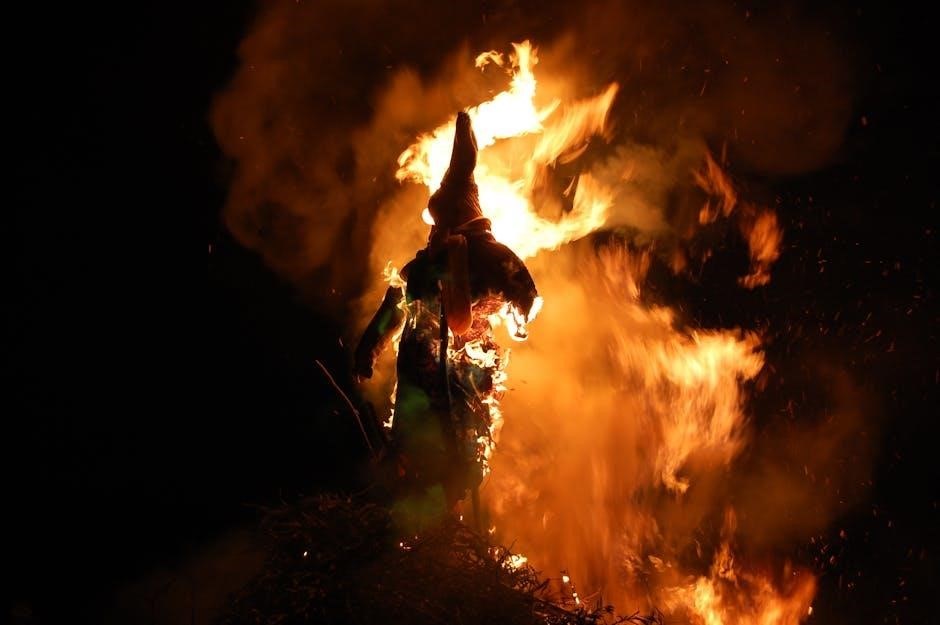
Practical Applications of Burning
Burning rituals offer versatile tools for protection, healing, and divination. Fire’s transformative power cleanses spaces, attracts positive energy, and aids in releasing negativity, making it a potent magical practice.
9.1 Using Fire for Protection
Fire is a powerful tool for protection, creating a barrier against negative energies. Burning sacred woods, resins, or herbs like sage or dragon’s blood repels harm and attracts positive vibes. Lighting protective candles, such as black or red ones, sets intentions for safety and strength. This practice cleanses spaces, shields from harmful influences, and invokes divine protection, fostering a secure environment for well-being and peace.
9.2 Burning for Healing and Cleansing
Burning rituals are potent for healing and cleansing, using fire’s transformative energy to restore balance. Sacred herbs like sage, sweetgrass, and palo santo are burned to purify spaces and bodies, dispelling negativity. The smoke carries intentions, cleansing auric fields and promoting emotional renewal. Candles and resins like myrrh and frankincense are used to heal and protect, fostering a serene environment. This practice revitalizes energy, harmonizes the spirit, and supports holistic well-being through ancient, time-tested traditions.
9.3 Fire in Divination and Scrying
Fire’s mesmerizing dance offers a gateway to divination and scrying, connecting practitioners to realms beyond the physical. Gazing into flames or candlelight, witches access visionary states, seeking guidance and insights. Smoke patterns from burning herbs reveal symbolic messages, while flickering lights signal omens or answers to questions. This ancient practice bridges the material and spiritual worlds, allowing witches to tap into hidden truths, foresee possibilities, and align with divine wisdom, enhancing intuition and inner knowing through the sacred element of fire.

Tools and Materials for Burning Rituals
Essential tools include candles, herbs, resins, and fire-safe containers. Sacred woods like birch and rowan enhance rituals, while specific materials amplify intentions for purification, protection, and transformation.
10.1 Essential Tools for Safe Burning
Fire-safe containers, like metal or glass bowls, are crucial for containing flames. Use a snuffer to extinguish candles safely, avoiding blown wax splatters. Herbal blends should be stored in airtight containers to preserve potency. High-quality candles ensure steady flames, while matches or lighters ignite materials effectively. Keep water nearby for emergencies. These tools ensure rituals are conducted safely, honoring fire’s power while preventing accidents.
10.2 Choosing the Right Herbs and Resins
Selecting herbs and resins involves considering their magical properties and scents. Sage cleanses and purifies, while sweetgrass attracts positivity. Dragon’s blood resin enhances protection rituals, and myrrh supports grounding. Always source high-quality, sustainably harvested materials to ensure effectiveness. Store them in airtight containers to preserve potency. Each herb and resin carries unique energy, making thoughtful selection vital for aligning with your intentions and enhancing ritual outcomes. Research their meanings to choose wisely.
10.3 The Role of Candles in Rituals
Candles are a powerful tool in witchcraft, representing the elements of fire and light. They serve as focal points for intentions, creating a sacred space for rituals. Different colors symbolize specific energies, such as red for passion or blue for calm. Candles can be dressed with oils or herbs for enhanced potency. Burning them amplifies spells, while their soft glow aids meditation. Proper extinguishing with a snuffer respects the magic, ensuring safe and effective practice. Candles embody transformation and spiritual connection.

Timing Your Burning Ritual
Burning rituals are timed to align with lunar phases, seasonal shifts, and specific days to enhance energy focus and intentional practices, creating a sacred space for transformation.
11.1 Aligning with Lunar Phases
Burning rituals often align with lunar phases to enhance their potency. The new moon is ideal for setting intentions, while the full moon is perfect for releasing negativity. Waxing moons support growth, and waning moons aid in letting go. By synchronizing rituals with the moon’s cycles, practitioners amplify their magic, ensuring their desires resonate deeply with the universe’s natural rhythms. This harmonious timing strengthens spells and fosters spiritual balance.
11.2 Seasonal Burning Rituals
Seasonal burning rituals connect practitioners with nature’s cycles, enhancing their magic. Spring rituals focus on renewal, burning away winter’s stagnation. Summer solstice fires symbolize peak energy and growth. Autumn rituals release what no longer serves, while winter fires ignite rebirth and introspection. Each season offers unique energy, allowing witches to tailor their practices, ensuring rituals resonate with Earth’s rhythms and deepen their spiritual connection to the ever-changing world around them.
11.3 Burning During Specific Days
Burning rituals on specific days amplify intentions, leveraging planetary and lunar energies. Full moons are ideal for release and transformation, while new moons seed new beginnings. Sabbats like Beltane and Samhain align with fire’s power for renewal and honoring ancestors. Certain weekdays, governed by planets, enhance specific goals—Mars for strength, Mercury for clarity. Timing rituals with celestial events and cultural traditions ensures powerful, focused magic, connecting witches to cosmic and seasonal flows for optimal results and spiritual growth.
Burning rituals offer profound transformation and renewal, embodying fire’s ancient magic. By embracing these practices responsibly, witches can harness fire’s power for healing, growth, and spiritual evolution, fostering a deeper connection with nature and their inner selves.
12.1 Final Thoughts on Burning Rituals
Burning rituals are a timeless and versatile practice, offering witches a powerful way to connect with fire’s transformative energy. Whether through candles, herbs, or paper, these rituals allow for release, cleansing, and renewal. Embrace fire’s magic responsibly, using it to purify, manifest, and honor life’s cycles. By integrating burning rituals into your craft, you can deepen your spiritual journey, fostering growth and harmony in all aspects of life.
12.2 Encouragement to Practice Responsibly
Practicing burning rituals demands mindfulness and respect for fire’s power. Always prioritize safety, ensuring a controlled environment and proper tools. Honour fire’s sacred role by using ethically sourced materials and performing rituals with clear intentions. Remember, magic is a force for good—use it wisely to foster balance and positivity. By doing so, you not only protect yourself but also align with the ethical principles of witchcraft, ensuring a meaningful and responsible practice.
12.3 The Endless Possibilities of Fire Magic
Fire magic offers boundless opportunities for growth and transformation. From cleansing spaces to manifesting desires, its versatility allows witches to tailor rituals to specific needs. Whether through candles, herbs, or sacred woods, fire’s energy can amplify intentions, foster renewal, and deepen spiritual connections. Embrace its dynamic potential to explore new dimensions of spellwork, divination, and personal evolution, making it a cornerstone of your magical journey and a testament to nature’s enduring power and wisdom.

